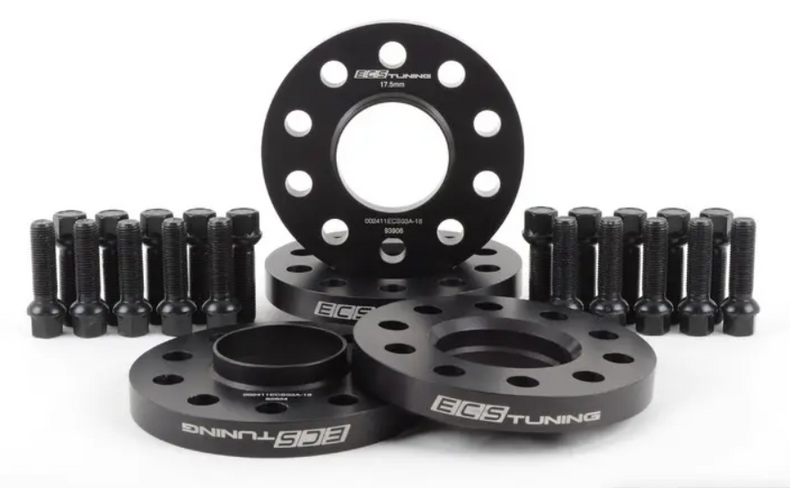Wheel spacers are devices that fit between a car's wheel hub and its wheel, effectively pushing the wheel outwards from the vehicle. They are commonly used to improve the appearance of a car by creating a wider stance, as well as to provide additional clearance for larger brake systems or different wheel offsets.
How do I choose wheel spacers?
Choosing the right wheel spacers for your vehicle involves several considerations. Here are some factors to keep in mind when choosing wheel spacers:
Bolt Pattern: The wheel spacer must match the bolt pattern of your car. This is usually expressed as a series of numbers, such as "5x114.3," which indicates that the car has five lug nuts on a bolt circle with a diameter of 114.3 millimeters. Make sure to choose wheel spacers with the same bolt pattern as your car.
Thickness: The thickness of the wheel spacer will determine how much the wheel is pushed outwards. A thicker wheel spacer will create a more aggressive look, but it can also affect the handling of the car. Be sure to choose a thickness that provides the desired look without compromising safety.
Material: Wheel spacers are available in various materials, including aluminum and steel. Aluminum is lightweight and offers good corrosion resistance, while steel is more durable and better suited for heavy-duty applications.
Hub-centric vs. Lug-centric: Hub-centric wheel spacers have a centering ring that fits snugly on the hub of the car, while lug-centric wheel spacers rely on the lug nuts to center the wheel. Hub-centric wheel spacers are generally considered to be safer and more reliable, especially for high-performance applications.
Brand and Quality: Choose a reputable brand and quality wheel spacers to ensure safety and reliability. Cheap or poorly made wheel spacers can cause vibration, wheel wobble, or even failure.
ProTip Takeaway: It's important to consult with a professional mechanic or automotive specialist to determine the appropriate wheel spacers for your specific car and intended use. They can help you choose the right size, material, and quality of wheel spacers to ensure a safe and effective installation.
Types of wheel spacers
There are different types of wheel spacers available on the market, and they can be categorized based on their thickness, material, and installation method. Here are some of the most common types of wheel spacers:
1. Bolt-On Wheel Spacers: These are the most common type of wheel spacers and are installed between the hub and the wheel. They come with bolts or studs and require longer lug nuts to secure them in place.
2. Slip-On Wheel Spacers: These spacers are designed to slip over the existing studs on the hub and are secured with lug nuts.
3. Hub-centric Wheel Spacers: These spacers have a centering ring that fits snugly on the hub of the car, ensuring a perfect fit and eliminating any wobble or vibration.
4. Lug-centric Wheel Spacers: These spacers rely on the lug nuts to center the wheel, and they are less expensive than hub-centric spacers. However, they may cause wobbling or vibration in some cases.
5. Adjustable Wheel Spacers: These spacers are designed to be adjustable, allowing you to change the width of your car's stance depending on your needs.
Shop for these top Brands:
Rennline (specialize in Porsche wheel spacers)
Turner Motorsport (specialize in BMW wheel spacers)
Flush fit kit (bring your OEM wheels flush with the fender lip)
How do I Measure for Wheel Spacers?
To measure for wheel spacers, you will need a few basic tools, including a tape measure, a ruler, and a caliper. Here's a step-by-step guide:
Measure your vehicle’s wheel gap: You will need to know the distance between your fender lip and the outer edge of your wheels. Wheel spacers that are up to and including 12mm will not rub.
Measure the current wheel offset: This is the distance between the mounting surface of the wheel and the centerline of the wheel. Measure this distance in millimeters and write it down.
Measure the clearance between the wheel and suspension: You need to ensure that there is enough clearance between the wheel and the suspension after installing the wheel spacers. Measure the clearance using a ruler or caliper.
Determine the desired wheel spacing: To achieve the desired look or performance, determine how much you want to push the wheels outwards. This will depend on your specific preferences and the make and model of your car.
Calculate the required spacer thickness: Subtract the current wheel offset from the desired wheel spacing. The result is the thickness of the wheel spacer that you need.
Determine the vehicle’s thread pitch: The thread pitch refers to the distance between each thread on a bolt, and it's usually expressed in metric units. Once you have determined the thread pitch of your car's bolts, you can choose wheel spacers that have bolts with the same thread pitch. For example, if your car's bolts have an M14x1.5 thread pitch, you should choose wheel spacers that have M14x1.5 bolts.
ProTip Takeaway: It's important to ensure that the length of the spacer bolts matches the length of your car's standard bolts, plus any additional length required for the spacer thickness. This will ensure that the spacer bolts provide a secure and safe connection between the wheel and the car's hub.











